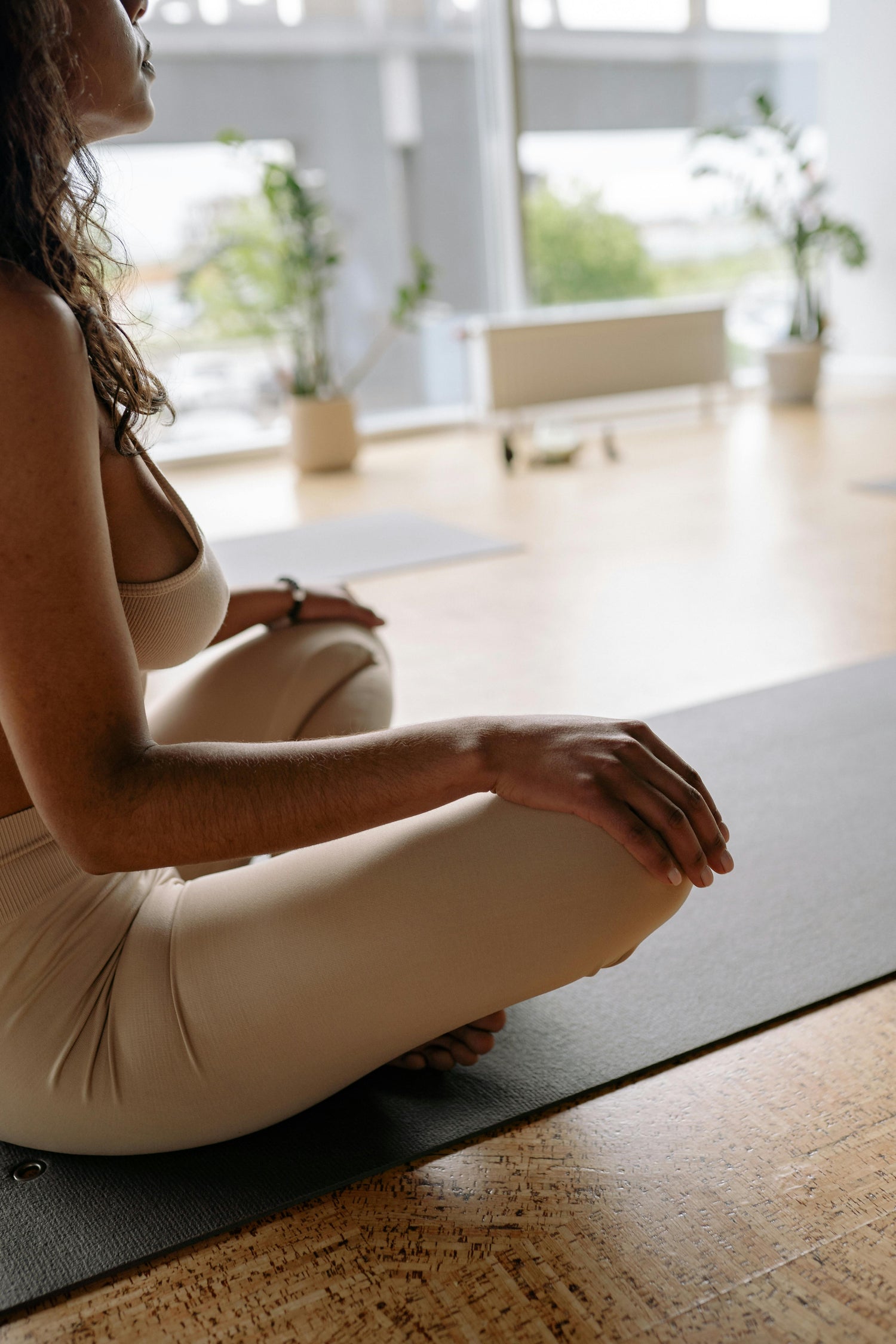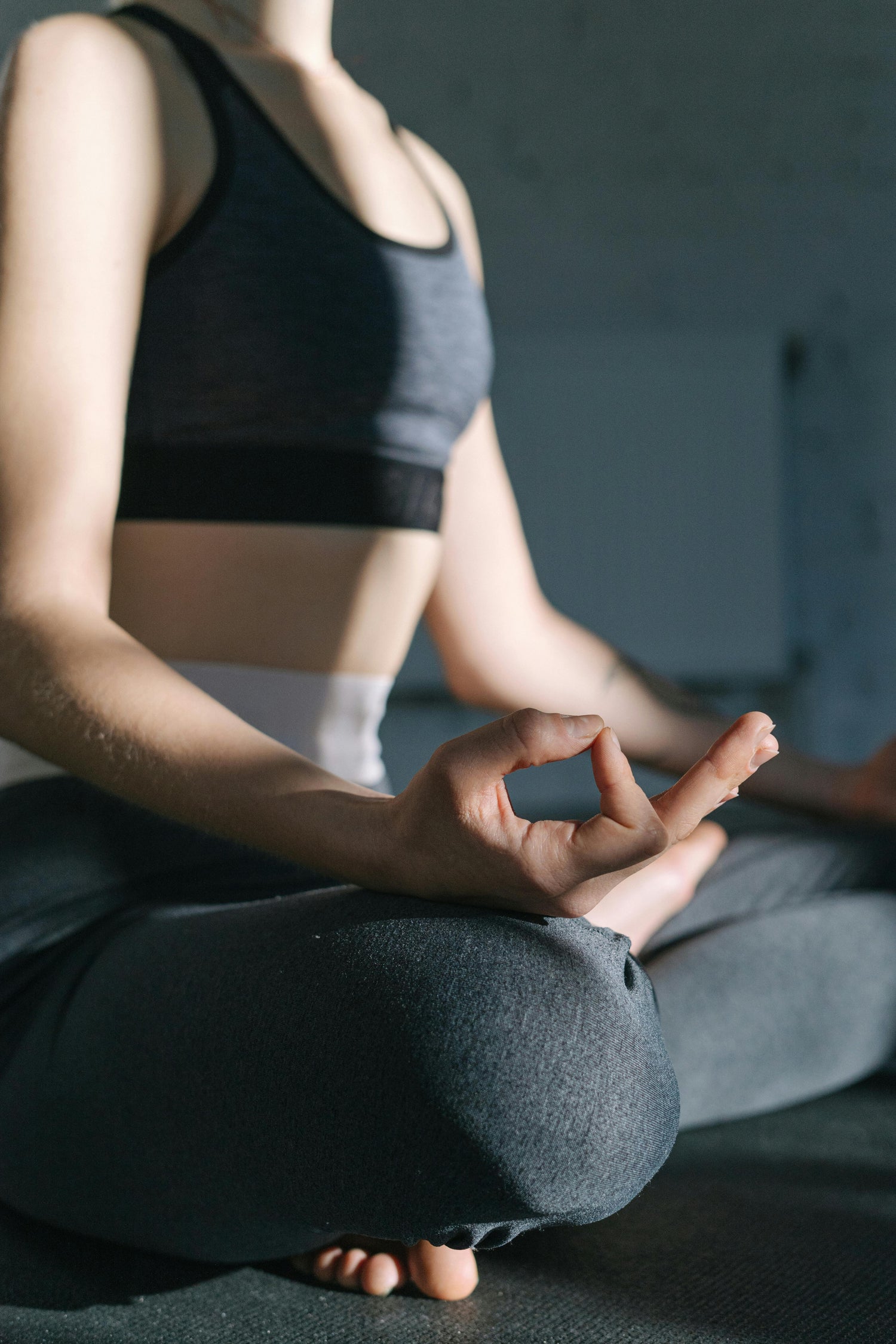YOGA BREATHING TECHNIQUES: CALM & ENERGY EVERY DAY
2025, a start to the year marked by tensions and challenges, but also an opportunity to refocus.
Discover 5 simple and effective yoga breathing techniques called pranayama to relieve stress, improve your concentration, and revitalize your daily energy. An invitation to regain control of your breathing and cultivate your inner well-being.
Written by Valentine - January 2025
Collapsible content
Reading time
About 10 minutes
WHAT YOU ARE ABOUT TO DISCOVER
- Why breathing is a powerful tool in yoga , and how it acts as a bridge between body and mind.
- Square breathing (Sama Vritti) : a method for balancing the mind and calming emotions.
- 4-7-8 Breathing : A Simple Technique to Reduce Anxiety and Improve Sleep
- Alternate Nostril Breathing (Nadi Shodana) : A traditional practice to harmonize your energies and clarify the mind.
- Bee Breath (Bhramari) : How to release tension through the soothing power of sound.
- Breathing called the breath of fire (Kapalabhati) : a dynamic technique to purify the body and energize your vital energy.
- Concrete examples to integrate these practices into your daily life , and their benefits on your physical and mental well-being.
- "Let's take a look"!

BREATH, THE KEY TO WELL-BEING: WHY CONTROL YOUR BREATHING?
Presentation :
Breathing, often unconscious, is nevertheless a powerful bridge between body and mind. It reflects our emotional state and, in turn, directly influences our mental and physical balance. By mastering your breathing, you can calm your mind, reduce stress, and improve your overall energy.
Positive impact of yoga:
Pranayama helps control breathing to regulate nervous system activity. Extended or rhythmic breathing techniques activate the parasympathetic nervous system, reducing stress levels and promoting a state of deep relaxation.
Concrete examples:
- In California: Square breathing workshops are being offered in fire-affected areas to help people manage post-traumatic anxiety.
- In France: Wellness centers offer pranayama classes to learn how to calm stress linked to mental overload.
- In Japan: Companies are incorporating guided breathing exercises into their wellness programs to counter employee burnout.
Summary:
Breathing, much more than an automatic reflex, is an essential key to transforming stress into serenity and strengthening your resilience.

SQUARE BREATHING: REGAIN BALANCE IN 4 STEPS
Presentation :
Sama Vritti Pranayama , or "square breathing," is a breathing technique that harmonizes the four phases of breath: inhalation, retention with full lungs, exhalation, and retention with empty lungs. Each phase lasts an equal amount of time, creating a steady, soothing rhythm that's ideal for calming the mind and balancing emotions. Accessible to all, this practice is a simple and powerful tool for regaining serenity and focus.
Positive impact:
Square breathing is known for:
- Reduce stress and calm intrusive thoughts.
- Improve concentration by focusing attention on a rhythmic breathing pattern.
- Stabilize strong emotions and soothe internal tensions.
- Prepare the body and mind for deep, restorative sleep.
How to practice square breathing:
- Sit or lie down in a comfortable position with your back straight and shoulders relaxed.
- Inhale slowly through your nose for a count of 4.
- Hold your breath, lungs full, for 4 counts.
- Exhale gently through your nose for 4 counts.
- Remain with empty lungs for 4 counts before starting the cycle again.
- Practice for 1 to 5 minutes, depending on your needs and comfort.
Concrete examples of use:
- Before a stressful event, such as an important meeting or an exam, to calm your mind and approach the situation with serenity.
- Before sleeping, to slow your breathing and calm mental agitation.
- In the middle of the day, to refocus during a break and boost your mental energy.
- With children, as a simple and fun exercise to help them find calm.
Summary:
Sama Vritti Pranayama is a universal technique that offers a perfect balance between simplicity and effectiveness. By regulating the breath, this practice creates inner harmony, reduces tension, and promotes lasting well-being.

4-7-8 BREATHING: A TOOL TO RELIEVE ANXIETY AND SLEEP BETTER
Presentation :
4-7-8 breathing, popularized by Dr. Andrew Weil, is a simple relaxation technique that works directly on the nervous system. Using a specific breathing pattern—inhale for 4 counts, hold for 7 counts, and exhale for 8 counts—this method promotes a deep sense of calm, ideal for reducing anxiety and preparing the body for restful sleep.
Positive impact:
4-7-8 breathing helps to:
- Activate the parasympathetic system, thus reducing stress and intrusive thoughts.
- Slows the heart rate, promoting an immediate feeling of calm.
- Prepare the body and mind for deep, restorative sleep.
- Calm strong emotions such as anger or agitation.
How to practice 4-7-8 breathing:
- Sit or lie down comfortably with your back straight and shoulders relaxed.
- Inhale slowly through your nose for 4 counts, filling your lungs.
- Hold your breath for 7 counts, remaining relaxed and still.
- Exhale gently through your mouth for 8 counts, making a gentle hissing or controlled breath.
- Repeat the cycle 4 to 8 times, depending on your comfort and needs.
Concrete examples of use:
- Before sleeping, to calm mental agitation and prepare the body for deep sleep.
- During an anxiety attack, to slow your heart rate and regain control of your emotions.
- After a stressful situation, such as an argument or work overload, to release tension and regain your calm.
- During a break at work, to reduce mental pressure and refocus.
Why does it work?
This technique uses a prolonged exhalation that promotes the elimination of carbon dioxide, slows breathing, and creates a state of relaxation. By synchronizing the breath with this specific pattern, the brain receives a safety signal, which reduces activity in the amygdala, the area responsible for stress responses.
Summary:
4-7-8 breathing is a gentle, quick, and effective method for calming the body and mind. Whether it's to manage anxiety, improve your sleep, or simply refocus, this practice is easy to integrate into your daily routine and provides immediate benefits.

ALTERNATE NOISE BREATHING: NADI SHODHANA FOR BALANCING ENERGIES
Presentation :
- Nadi Shodhana , or alternate nostril breathing, is a pranayama technique that balances energy flows by alternating breathing between the two nostrils.
- In Sanskrit, "Nadi" means "energy channel" and "Shodhana" means "purification."
- It is known to harmonize energies, calm the mind and improve concentration.
- Traditionally practiced before meditation, this method helps calm scattered thoughts and reduce stress.
Positive impact:
- Harmonizes the active (masculine) and receptive (feminine) energies of the body.
- Soothes mental tension, reducing intrusive thoughts and stress.
- Promotes better focus and increased mental clarity.
- Purifies the respiratory tract and strengthens the circulation of vital energy.
How to practice:
- Sit comfortably in a meditative posture with your back straight and shoulders relaxed.
- Place your left hand on your knee in Jnana Mudra and use your right hand to alternate breathing.
- Block the right nostril with your thumb and inhale slowly through the left nostril.
- Block the left nostril with your ring finger, unblock the right nostril and exhale gently.
- Alternate between both nostrils to create a balanced, rhythmic flow.
- Practice for 5 to 10 minutes for optimal effects.
Concrete examples of use:
- Before meditation, to prepare the mind and enter a state of deep calm.
- In the morning, to balance your energies and start the day with clarity.
- After a long period of concentration or work, to relieve mental stress.
- During a period of emotional turmoil, to regain inner balance and a feeling of serenity.
Summary:
Nadi Shodhana , or alternate nostril breathing, is an essential practice for restoring energetic and mental balance. It calms the mind, purifies the body, and improves concentration, making it an essential tool for cultivating serenity in everyday life.

BEE BREATHING: STRESS RELIEF THROUGH SOUND
Presentation :
Bhramari Pranayama , or "bee breathing," gets its name from the characteristic buzzing sound produced during exhalation, similar to the sound of a bee. This pranayama technique is particularly soothing to the nervous system, as it uses sound vibrations to calm the mind, release tension, and improve concentration.
Bhramari Pranayama is ideal for reducing stress, calming strong emotions, and refocusing after a hectic day. It is accessible to everyone, from children to adults, and can be practiced at any time to restore a state of inner calm.
Positive impact:
- Instantly calms the mind, reducing intrusive thoughts and anxiety.
- Releases physical tension, especially in the jaw, face and neck.
- Improves focus and mental clarity with soothing vibrations.
- Stimulates the vagus nerve, promoting deep relaxation and emotional regulation.
How to practice:
- Sit comfortably in a meditative posture with your back straight and shoulders relaxed.
- Place your fingers on the cartilages of the ears (as if to slightly close the ear canals) or in mudra, depending on your comfort.
- Inhale deeply through your nose.
- While exhaling, with your mouth closed, make a soft, continuous humming sound (the "mmmm" sound).
- Focus on the vibrations in your head, chest, and throat.
- Repeat the cycle 5 to 10 times, adjusting the duration as needed.
Concrete examples of use:
- After a stressful day, to calm the mind and release accumulated tension.
- Before meditation, to calm the mind and create a state of deep concentration.
- With children, to help them channel their energy and relax before going to sleep.
- During a break, to reduce anxiety and regain a feeling of immediate calm.
Why does it work?
- The sound vibrations produced by Bhramari Pranayama stimulate the vagus nerve, which activates the parasympathetic nervous system, responsible for the state of relaxation and recovery.
- These vibrations also calm areas of the brain associated with fear and stress, providing an immediate sense of peace.
Summary:
Bee Breath, or Bhramari Pranayama , is a simple, accessible, and incredibly effective technique for calming the mind, releasing tension, and cultivating inner serenity. It's perfect for anyone looking to calm their mind and regain emotional balance in their daily lives.

THE BREATH OF FIRE: ENERGIZE YOUR LIFE ENERGY WITH KAPALABHATI
Presentation :
Kapalabhati , or "breath of fire," is a dynamic pranayama technique that combines active, forced exhalations with natural, passive inhalations. In Sanskrit, "Kapala" means "skull" and "Bhati" means "radiance" or "light," as this practice is said to clarify the mind and energize life energy.
Traditionally, Kapalabhati is considered a kriya (purification practice) rather than a breathing exercise. It is used to purify the respiratory system, stimulate digestion, and revive the body's energy. It is a powerful method for awakening vitality and purifying the mind.
Positive impact:
- Purifies the respiratory tract by removing toxins from the lungs and sinuses.
- Energizes the body and mind, helping to overcome fatigue and regain energy.
- Improves mental clarity and focus through increased oxygenation.
- Stimulates the digestive system and activates metabolism.
- Releases emotional and physical tension, providing a feeling of lightness and vitality.
How to practice Kapalabhati:
- Sit in a comfortable posture (Sukhasana, Padmasana or Vajrasana) with your back straight and shoulders relaxed.
- Inhale deeply through your nose to fill your lungs.
- Exhale quickly through your nose while contracting your abdominal muscles. Exhalation is active and dynamic, while inhalation is passive.
- Maintain a constant rhythm, with approximately one exhalation per second.
- Practice a set of 20 to 30 cycles, then take a break breathing normally before starting again.
Concrete examples of use:
- In the morning, to awaken your energy and prepare your body and mind for the day.
- Before a yoga or meditation session, to purify your mind and oxygenate your body.
- In case of mental or physical fatigue, to revitalize your energy and improve your concentration.
- After a light meal, to stimulate digestion and boost your metabolism.
Why does it work?
- Repeated contractions of the diaphragm massage the internal organs, stimulating the digestive system and improving metabolism.
- The increased oxygen supply revitalizes the body's cells and clears the mind.
- This practice also acts as an energetic cleanse, removing blockages and promoting a free flow of prana (life energy).
Summary:
Kapalabhati , or Breath of Fire, is an essential technique for purifying the body, energizing the mind, and clarifying the spirit. Perfect for revitalizing your energy and cultivating overall well-being, Kapalabhati easily integrates into your daily routine and offers immediate and lasting benefits.

EXPLORE THE POWER OF YOUR BREATH TODAY
Ready to discover the power of your breath?
Try one of these breathing techniques today!
Breath is much more than just a biological mechanism. It is a guide, an inner compass capable of transforming our mental, emotional, and physical state. Each yoga breathing technique, whether gentle like Bhramari Pranayama (bee breath) or dynamic like Kapalabhati (breath of fire), acts as a key to accessing a better version of ourselves.
By mastering your breath, you gain control of your emotions, calm your mind, and release the vital energy within you. These ancient practices are particularly relevant in the modern context, where stress, anxiety, and mental overload dominate our daily lives. Whether you're looking to calm a hectic day, harmonize your thoughts, or regain your vitality, breath yoga offers solutions tailored to your needs.
Adopting a pranayama routine, even for a few minutes a day, can not only transform your immediate well-being but also anchor you in a lasting practice for facing life's challenges. The breath, universal and accessible to all, is your primary tool for transformation. So, take a deep breath and let it guide you to greater calm, clarity, and energy.
Thanks for this news post!
HEALTHY MIND, HEALTHY LIFE
Valentine's Bio
-

VALENTINE
1994, Reunion Island, Mauritius, a Life carried by the Indian Ocean and Yoga
Since childhood, this intrepid traveler has traveled the globe, leaving her footprints on beaches around the world.Passionate about surfing, scuba diving and sailing, she has made the oceans her playground and source of inspiration.
The freedom of the waves, the serenity of the ocean depths and the wind in his sails have punctuated his journey, always guided by a quest for connection with nature.
It was through her explorations that yoga became more than a practice for her – it was a way of life.
Between early morning surf sessions and meditative sunsets, she found in yoga a perfect balance of strength, flow and self-awareness.
Today, she combines her passion for water sports with teaching yoga and is part of the Yogaterrae team, here in France, in the South West and often remotely :)
This adventurer is a true source of inspiration for anyone who aspires to live in harmony with their body and nature.
Through her stories of incredible experiences, she invites everyone to open up to a world where every wave, every breath and every posture is a celebration of life.



